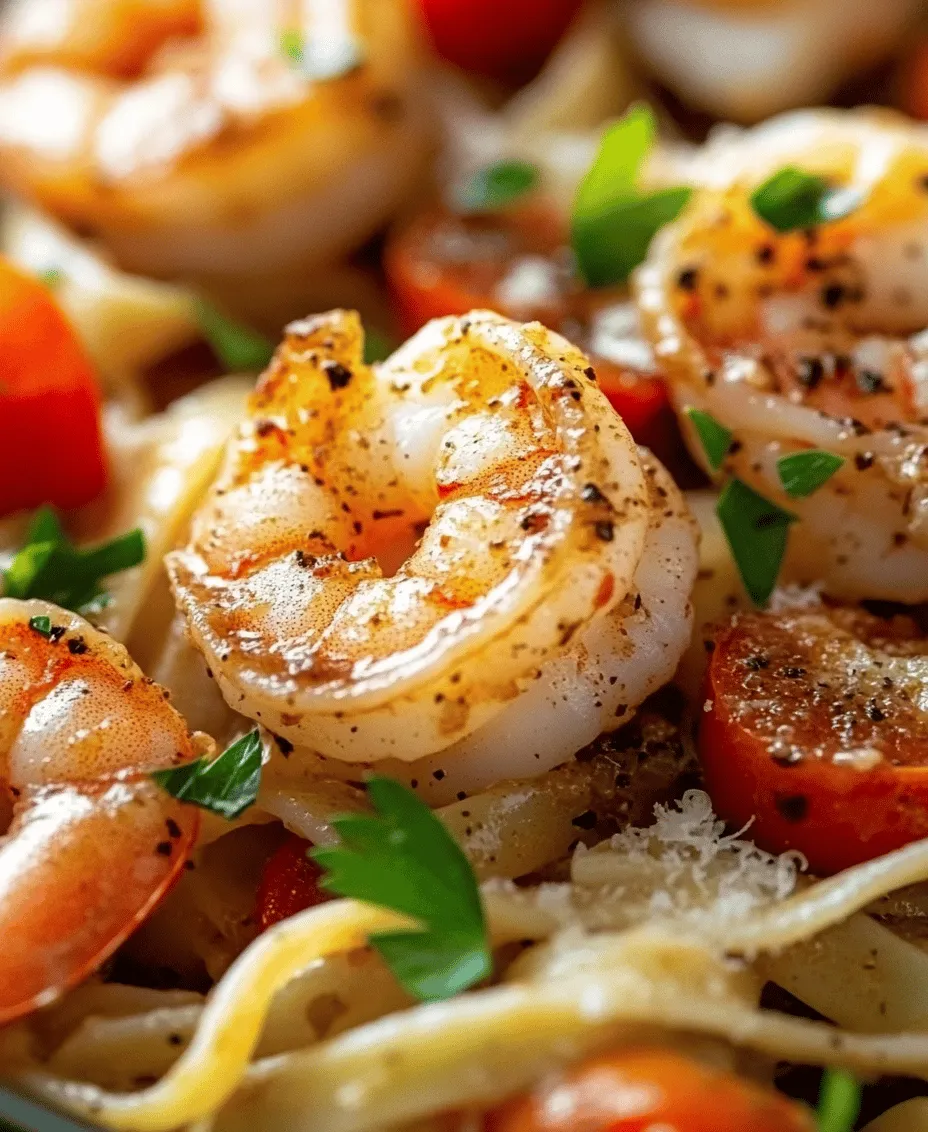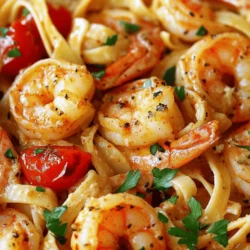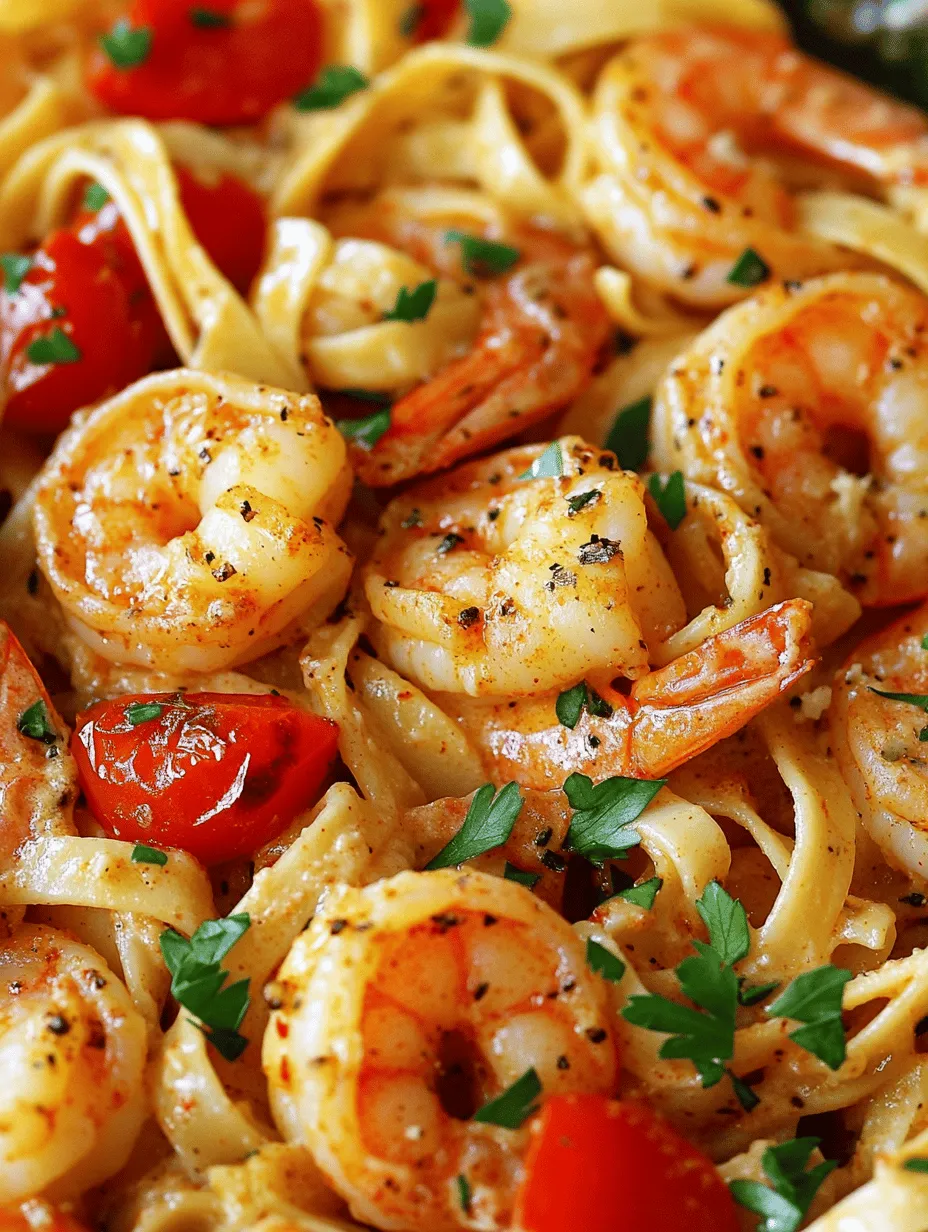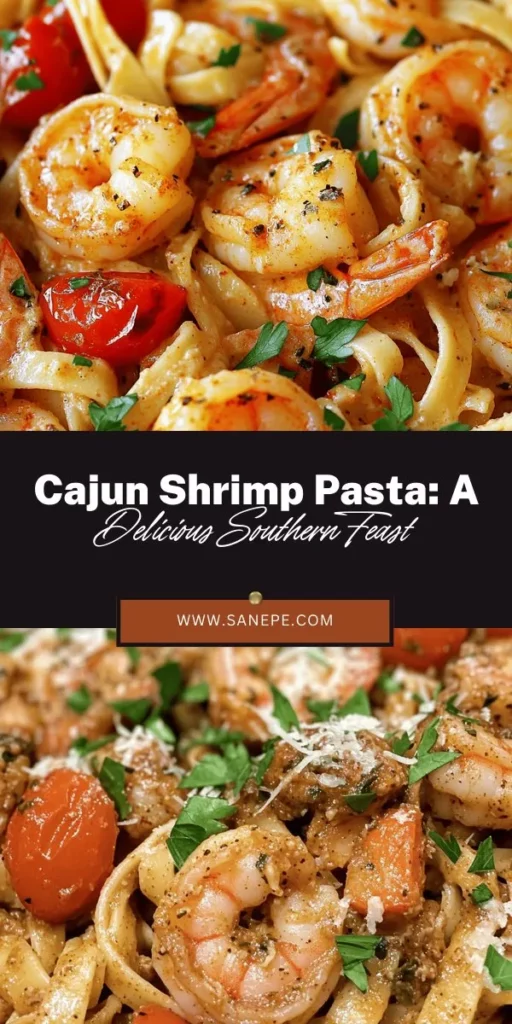Delve into the vibrant flavors of Southern cuisine with this Cajun Shrimp Pasta Delight. Combining the richness of creamy fettuccine with the bold spices of Cajun seasoning, this dish is not only a feast for the senses but also a quick and easy option for weeknight dinners or special occasions. Cajun Shrimp Pasta Delight is a symphony of textures and tastes that showcases the essence of Cajun cooking, making it a perfect meal for both novice cooks and seasoned chefs alike.
In this article, we will explore the origins of Cajun cuisine, the health benefits of its ingredients, and provide a step-by-step guide to preparing this delectable dish that serves four. Whether you’re looking to impress guests or simply treat yourself to a comforting meal, this Cajun Shrimp Pasta is sure to become a favorite in your culinary repertoire.
Understanding Cajun Cuisine
The Roots of Cajun Cooking
Cajun cuisine has its origins deeply embedded in the rich cultural tapestry of Louisiana. Influenced by French settlers who arrived in the 17th century, Cajun cooking evolved from a blend of French, Spanish, African, and Native American culinary traditions. The word “Cajun” itself comes from the Acadian people, who were exiled from Canada and settled in Louisiana. This melting pot of cultures has resulted in a distinctive style of cooking that emphasizes bold flavors, hearty ingredients, and a strong sense of community.
At the heart of Cajun cuisine are the “holy trinity” of ingredients: onions, bell peppers, and celery. These foundational elements create a flavor base for many dishes, including gumbo, jambalaya, and of course, our featured Cajun Shrimp Pasta Delight. The use of spices is also a defining characteristic of Cajun cooking, with cayenne pepper, paprika, and thyme being staples in the kitchen.
Key Ingredients that Define Cajun Dishes
Cajun dishes are often characterized by their use of fresh, locally sourced ingredients. Seafood, particularly shrimp, is a significant component, reflecting Louisiana’s coastal geography. Additionally, meats such as andouille sausage and chicken are popular choices. The emphasis on seasonal vegetables means that you can find a variety of produce in Cajun recipes, enhancing both flavor and nutrition.
Cajun cooking is not just about sustenance; it’s also about celebrating life and community. The act of cooking and sharing meals is deeply ingrained in Cajun culture, making it an experience rather than just a task. This sense of hospitality extends to Cajun Shrimp Pasta Delight, which is perfect for gatherings and family dinners.
The Appeal of Shrimp in Cajun Dishes
Nutritional Benefits of Shrimp
Shrimp plays a starring role in many Cajun dishes, including our pasta delight. This seafood option is not only delicious, but it also boasts impressive nutritional benefits. Shrimp is known for its high protein content and low calorie count, making it an excellent choice for those looking to maintain or lose weight while still enjoying flavorful meals.
A 3-ounce serving of shrimp contains approximately 20 grams of protein, which is essential for muscle growth and repair. Additionally, shrimp is rich in essential nutrients such as selenium, which supports immune function, and vitamin B12, vital for nerve health and energy production.
When considering sustainability, it is crucial to source shrimp responsibly. Look for shrimp that is certified by organizations such as the Marine Stewardship Council (MSC) or the Aquaculture Stewardship Council (ASC). This ensures that the shrimp you enjoy is not only healthy for you but also for the oceans and ecosystems from which they come.
Ingredient Breakdown for Cajun Shrimp Pasta Delight
Fettuccine Pasta
The choice of pasta can significantly impact the overall experience of your dish. For this Cajun Shrimp Pasta Delight, fettuccine is the ideal choice, thanks to its broad, flat shape that captures the creamy sauce beautifully. This pasta has a delightful chewiness that complements the tender shrimp and fresh vegetables perfectly.
If you’re looking for gluten-free alternatives, consider using rice noodles or gluten-free pasta made from chickpeas or lentils. These options can provide a similar texture while catering to dietary restrictions.
Large Shrimp
When preparing Cajun Shrimp Pasta, selecting the freshest shrimp is essential. Look for large shrimp, ideally U.S. wild-caught, as they offer the best flavor and texture. Fresh shrimp should have a mild, briny smell and a firm texture.
Understanding the differences between types of shrimp can enhance your cooking experience. For example, Gulf shrimp are known for their sweetness, while Pacific shrimp are often more versatile and slightly firmer. For convenience, using peeled and deveined shrimp is recommended, as this saves time during preparation and allows you to focus on perfecting the dish.
Cajun Seasoning
Cajun seasoning is the heart and soul of this dish, infusing it with the unique flavors that define the cuisine. You can either use store-bought Cajun seasoning or make your own at home for a fresher taste. A homemade blend typically includes paprika, cayenne pepper, garlic powder, onion powder, thyme, and black pepper.
Using homemade seasoning not only allows you to control the heat level but also ensures that you are using high-quality spices. The health benefits of the spices commonly found in Cajun seasoning are numerous; for instance, paprika is rich in antioxidants, and cayenne pepper can boost metabolism and improve circulation.
Fresh Vegetables
In addition to shrimp and pasta, fresh vegetables play a critical role in enhancing the flavor profile of Cajun Shrimp Pasta Delight. Onions, garlic, bell peppers, and cherry tomatoes are commonly used in Cajun cooking, and each ingredient contributes its own unique flavor and nutritional value.
– Onions provide sweetness and depth when sautéed, while garlic adds an aromatic quality that elevates any dish.
– Bell peppers, particularly the red and green varieties, introduce a hint of sweetness and a pop of color, making the dish visually appealing.
– Cherry tomatoes bring a juicy burst of flavor that complements the creamy sauce and adds a refreshing element to the dish.
The inclusion of these vegetables not only enhances the taste but also boosts the nutritional content of the meal, providing vitamins A and C, fiber, and antioxidants.
Creamy Sauce Ingredients
The creamy sauce is what ties this dish together, creating a luxurious texture that coats the fettuccine and shrimp beautifully. Heavy cream is the primary ingredient, offering richness that balances the bold spices of the Cajun seasoning.
To enhance the flavor of the sauce, paprika and cayenne pepper can be added. These spices not only contribute to the overall taste but also come with their own health benefits. Paprika is known for its anti-inflammatory properties, while cayenne may aid in digestion and support a healthy metabolism.
With this foundational knowledge of Cajun cuisine and the ingredients that make up the Cajun Shrimp Pasta Delight, you are now ready to embark on the cooking journey. In the following sections, we will provide you with the step-by-step instructions to create this mouthwatering dish, ensuring that you can bring the vibrant flavors of Southern cooking right to your table.

Step-by-Step Instructions for Preparing Cajun Shrimp Pasta Delight
Cooking the Fettuccine
To achieve the perfect texture for your fettuccine, start by bringing a large pot of water to a rolling boil. Salt the water generously—this is essential as it enhances the flavor of the pasta. A good rule of thumb is to use about 1 tablespoon of salt for every 4-6 quarts of water. Once the water is boiling, add the fettuccine and cook according to the package instructions, typically around 10-12 minutes for al dente.
Tips for Achieving the Perfect Al Dente Texture
Al dente pasta should be firm to the bite, not mushy. To check for doneness, taste a strand of fettuccine a minute or two before the recommended cooking time ends. If it’s slightly undercooked but has a tender core, it’s ready to drain. Remember to reserve at least ½ cup of pasta water before draining; this starchy water is invaluable for adjusting the sauce’s consistency later.
Preparing the Shrimp
While the pasta cooks, it’s time to prepare your shrimp. Start with fresh or thawed shrimp, preferably large shrimp (16-20 count). Rinse the shrimp under cold water and pat them dry with paper towels to remove excess moisture, which can prevent a good sear when cooking.
How to Properly Season Shrimp for Maximum Flavor
Season the shrimp generously with Cajun seasoning, ensuring all sides are coated evenly. If you want to make your own Cajun seasoning, combine paprika, cayenne pepper, garlic powder, onion powder, dried oregano, and thyme. Allow the seasoned shrimp to rest for about 10 minutes; this will help the flavors penetrate and enhance the overall taste.
Techniques for Ensuring Even Cooking
Heat a large skillet over medium heat and add a tablespoon of olive oil or butter. Once the oil is glistening, carefully add the shrimp in a single layer. Avoid crowding the pan, as this can lead to steaming rather than sautéing.
Sautéing the Vegetables
While the shrimp cooks, it’s time to sauté your vegetables. Start with diced onions and bell peppers, followed by minced garlic.
Best Practices for Sautéing to Maintain Texture and Flavor
Add the onions and bell peppers to the skillet first, cooking them for about 3-4 minutes until they become tender. Then, add the minced garlic, sautéing for an additional minute. Garlic cooks quickly and can burn easily, so keep an eye on it to maintain its flavor.
Timing and Order of Vegetable Addition for Optimal Results
If you’re including other vegetables like zucchini or spinach, add them at this stage, as they require less cooking time. For instance, zucchini should cook for about 2-3 minutes until just tender, while spinach wilts in under a minute.
Cooking the Shrimp
Once the vegetables are sautéed, it’s time to return to the shrimp.
Visual Cues to Determine When Shrimp Are Perfectly Cooked
Cook the shrimp for 2-3 minutes on each side. The shrimp should turn pink and opaque when cooked through, with a slight curl shape. Be careful not to overcook, as shrimp can become rubbery and tough.
Balancing Heat to Avoid Overcooking
If your skillet is too hot, the shrimp may cook too quickly on the outside while remaining raw inside. Adjust the heat as needed to maintain a steady cooking temperature, ensuring even results.
Creating the Creamy Sauce
After the shrimp are cooked, remove them from the skillet and set them aside. In the same skillet, pour in 1 cup of heavy cream and bring it to a gentle simmer over medium heat.
Instructions for Thickening the Sauce Without Curdling
To thicken the sauce, whisk in ½ cup of grated Parmesan cheese while maintaining a low simmer. Stir continuously to prevent the cheese from clumping or the cream from curdling. If the sauce is too thick, add reserved pasta water a tablespoon at a time until the desired consistency is achieved.
Balancing Flavors with Salt and Pepper
Taste the sauce and adjust the seasoning with salt and freshly ground black pepper. You might also add a squeeze of lemon juice for brightness.
Combining Pasta and Sauce
Once the sauce reaches the desired consistency, add the cooked fettuccine directly into the skillet, tossing to coat the pasta evenly.
Ensuring Even Distribution of Sauce Over the Pasta
Use tongs or a pasta fork to mix thoroughly, making sure each strand of fettuccine is enveloped in creamy goodness. If the pasta seems dry, incorporate more of the reserved pasta water.
Final Heating Tips for Serving
Return the sautéed shrimp to the skillet and gently toss everything together until heated through, about 1-2 minutes. This allows the shrimp to absorb some sauce and meld with the flavors of the pasta.
Serving Suggestions and Pairings
Ideal Side Dishes
To complete your Cajun Shrimp Pasta Delight, consider serving it alongside a fresh green salad. A simple mix of arugula, cherry tomatoes, and a light vinaigrette will provide a refreshing contrast to the rich pasta. Alternatively, warm, crusty garlic bread is an excellent choice for sopping up any leftover sauce.
Complementary Salads or Bread Options to Accompany the Dish
A Caesar salad also pairs well, adding a bit of crunch and creaminess to complement the dish. If you prefer bread, opt for a baguette or focaccia, which can enhance the overall dining experience.
Beverage Pairings for Enhancing the Meal Experience
For beverages, consider a crisp white wine like Sauvignon Blanc, which can cut through the creaminess of the sauce. If you prefer non-alcoholic options, a sparkling water with lemon or a lightly sweet iced tea can refresh the palate between bites.
Garnishing for Presentation
Presentation is key to any meal, especially one as vibrant as Cajun Shrimp Pasta Delight.
Ideas for Elevating the Visual Appeal of the Dish
To garnish, sprinkle freshly chopped parsley over the top for a pop of color. This not only enhances the visual appeal but also adds a touch of freshness.
Using Fresh Parsley and Parmesan Cheese Effectively
Grate more Parmesan cheese over individual servings for added richness. Alternatively, you can serve the dish in a large, shallow bowl for family-style dining, allowing guests to help themselves while still showcasing the beautiful colors and textures of the ingredients.
Conclusion
Cajun Shrimp Pasta Delight is a celebration of flavors that encapsulates the essence of Cajun cooking. With its creamy sauce, perfectly cooked shrimp, and aromatic vegetables, this dish is sure to impress anyone at your dinner table. Whether you’re a novice in the kitchen or an experienced cook, this recipe offers a straightforward yet delicious way to explore the rich culinary traditions of the South. Enjoying this dish not only satisfies your taste buds but also connects you to a cultural heritage that values flavor, community, and tradition. So gather your ingredients, unleash your culinary creativity, and savor every delicious bite of this delightful dish.


